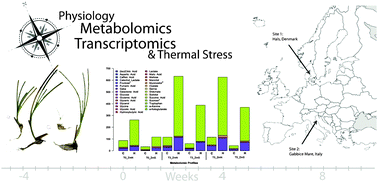The contribution of metabolism to heat stress may play a significant role in defining robustness and recovery of systems; either by providing the energy and metabolites required for cellular homeostasis, or through the generation of protective osmolytes. However, the mechanisms by which heat stress attenuation could be adapted through metabolic processes as a stabilizing strategy against thermal stress are still largely unclear. We address this issue through metabolomic and transcriptomic profiles for populations along a thermal cline where two seagrass species, Zostera marina and Zostera noltii, were found in close proximity. Significant changes captured by these profile comparisons could be detected, with a larger response magnitude observed in northern populations to heat stress. Sucrose, fructose, and myo-inositol were identified to be the most responsive of the 29 analyzed organic metabolites. Many key enzymes in the Calvin cycle, glycolysis and pentose phosphate pathways also showed significant differential expression. The reported comparison suggests that adaptive mechanisms are involved through metabolic pathways to dampen the impacts of heat stress, and interactions between the metabolome and proteome should be further investigated in systems biology to understand robust design features against abiotic stress.

You have access to this article
 Please wait while we load your content...
Something went wrong. Try again?
Please wait while we load your content...
Something went wrong. Try again?


 Please wait while we load your content...
Please wait while we load your content...